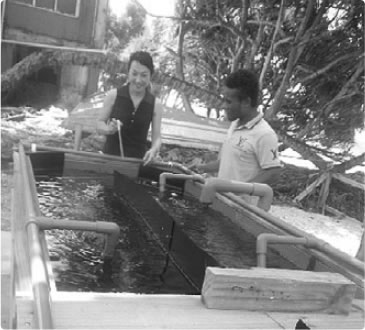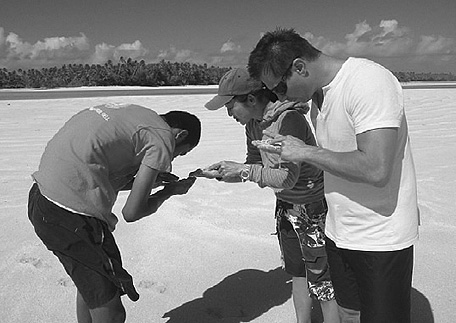Japan's Official Development Assistance White Paper 2011
Column 11
In Harmony with the Bountiful Life in Tuvalu
—Japan Survey Assistance in Tuvalu—

Ms. Matsudate growing forams (Mr. Paeniu on right) (Photo: Fumiko Matsudate)
Tuvalu is made up of nine atolls and islands that sparkle like a necklace in the South Pacific Ocean. The country located where the equator and international dateline meet enjoys a tropical maritime climate, with pleasant trade winds between May and October. Each island is small, and even Funafuti, the largest island that forms the capital, measures only some 12 kilometers long and 700 meters at its widest point. The land is flat and low, with elevation in most areas between 1 and 3 meters above sea level. Tuvalu is the focus of international attention as rising sea levels due to global warming threaten to submerge the island nation. The bounties of nature support the lives of the Tuvaluan people, but in Funafuti, this nature can also endanger the residents' lives, as underground water gushes out during high tides to flood roads and homes, and shoreline erosion knocks down palm trees.
One of the causes of this erosion is believed to be the decline in corals and foraminifera—forams for short, also known as "star sand"—that form the island. The population concentrating in the capital has led to an increase in wastewater, and perhaps the resulting pollution is hindering the survival of the forams. Manmade structures like banks are also likely blocking the drift of the star sand, preventing it from preserving and forming the island's ground.
Japan has assisted Tuvalu in a variety of fields such as port construction, technology transfer, and human resources development. And in 2009, it launched a project to survey the mechanism that sustains and forms the island (*1). By proposing measures based on this mechanism, the project hopes to enhance the nation’s resilience to climate change.
Fumiko Matsudate supervises activities on-site in Tuvalu as project coordinator. The project conducts various surveys, one of which is an experiment in growing forams. Once experts from Japan return home, it is up to Ms. Matsudate to work with Tuvaluan staff members and manage the progress of the experiment, and in other ways ensure that activities are carried out smoothly. In the beginning, she says having no experience in growing forams or in managing an aquarium gave her sleepless nights. What's more, the Tuvaluan staff members were not all that enthusiastic about the project, and she worried about how she would get along with them.
To spark their interest in the project, Ms. Matsudate decided to give the Tuvaluan staff members a chance to make presentations in their own words when they visited schools and attended meetings. Her plan proved effective, and gradually, the Tuvaluan staff members began to discuss their tasks and get more involved in the project.
There is an episode Ms. Matsudate will never forget. One Tuvaluan staff member, a Mr. Paeniu, at first appeared reluctant to take part in the project. When one day, he noticed that the mollusks in the aquarium might be eating the forams. Ms. Matsudate contacted her expert in Japan, and right away received instructions to remove the mollusks from the aquarium. This was on a Friday, and Ms. Matsudate suggested she and Mr. Paeniu put off the task until the following Monday. But Mr. Paeniu objected. He was determined to waste no time, and offered to come in the next day. And so although Saturday was their usual day off, the two of them delved into the aquarium and pulled out the mollusks. From that day on, Mr. Paeniu's awareness that he was raising the forams showed in his actions. He started to gather his colleagues from the national fishery department and take the initiative to clean the aquarium.
Now that the project has entered the second half of its duration, the challenge is to come up with a good way for the Tuvaluan people to protect their archipelago on their own.
Ms. Matsudate says she will be working even more closely with the residents, and she hopes to design activities they can continue—activities in harmony with the people of Tuvalu, who use their country’s limited natural resources wisely and live bountiful lives.
(*1) Project for Eco-technological Management of Tuvalu Against Sea Level Rise (2009–2014)

Holding and explaining about "star sand" (Photo: Fumiko Matsudate)
